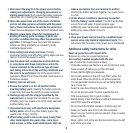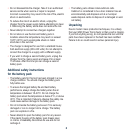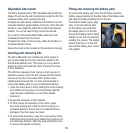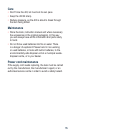14
Drilling metals
• For maximum performance, use high speed steel bits for
metal or steel drilling.
• Ensure that the torque adjustment / hammer selection
collar (2) is in normal drilling mode.
• Begin drilling at a very low speed to prevent the bit from
slipping off the starting point.
• Always clamp sheet metal.
• Support thin metal with a block of wood to avoid
distorting it.
• Use a punch to mark the centre of the hole.
• Use a suitable lubricant for the material you are
working on.
Use: for:
Oil Steel
Turpentine or paraffin Aluminium
Do not lubricate Brass, copper or cast iron
Drilling plastics and plastic coated chipboard
• Use high speed drill bits
• See drilling wood below
Drilling masonry
• For maximum performance use carbide-tipped masonry
impact bits when drilling holes in brick, tile, concrete etc.
• Turn the mode selector to hammer mode, then rotate the
torque collar to the drill position.
• Apply light pressure and medium speed for best results
in brick.
• Apply additional pressure and high speed for hard
materials such as concrete.
• When drilling holes in tile, practice on a scrap piece to
determine the best speed and pressure.
Drilling wood
• For maximum performance, use high speed steel bits for
wood drilling.
• Ensure that the mode selector is in normal drilling mode.
• Begin drilling at a very low speed to prevent the bit from
slipping off the starting point. Increase the speed as the
drill bites into the material.
• When drilling through holes, place a block of wood behind
the work piece to prevent ragged or splintered edges on
the back side of the hole.
• WARNING. Never attempt to lock the trigger switch in the
on position, do not lock the trigger on jobs where your
hammer drill may need to be stopped suddenly.
All drilling operations
• Mark off the centre of the hole using a centre punch
or nail.


















